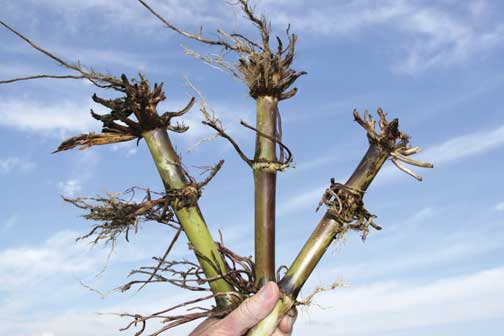Bt rootworm corn failures: Understanding the issues
|
Genetically engineered corn that produces a Bt toxin effective against corn rootworms is now readily available and was widely planted in Iowa during 2006. Several seed companies have registrations, or will have shortly, and they will add additional Bt events and varieties to the choices for corn rootworm management. Does that mean that our corn rootworm management decisions are over, and we don't have to worry about rootworm injury? No. Bt corn rootworm hybrids are another insect management tool that must be thoughtfully incorporated into corn production practices. The first assumption that must be examined is that Bt corn rootworm technology might be thought of as "bullet proof" and that corn rootworm injury will not occur. The University of Illinois has field trial data where the in-plant protected corn rootworm hybrids have not provided acceptable protection from larval feeding. This product failure appears to have happened in Iowa for the first time during the 2006 growing season. Instances of "unacceptable rootworm injury" to Bt corn in eastern Iowa were reported. We visited one of these fields, a field planted to a YieldGard® variety, and found between 1 1/2 to 3 nodes of roots destroyed by rootworms (see photos). This is significantly more injury than we have ever observed in our university evaluations. During 2003-2005, the average root injury to a Bt corn rootworm hybrid in our test plots averaged an extremely low node injury rating of 0.03. We do not have an explanation for the cause of the failure of Bt rootworm corn to provide adequate root protection. One possibility that has been proposed is that the rootworm population was exceptionally and unusually high. This theory is supported by the fact that the plants in the refuge where a soil insecticide was used had similar levels of root injury. This high level of injury also is much higher than the injury that insecticide sustains in our insecticide evaluation trials in spite of our insecticide trials being specifically designed to produce severe rootworm pressure. This would lend credibility to the theory that the rootworm populations were unusually high in this problem field. There could be other reasons as to why the Bt rootworm corn didn't provide adequate root protection. Possibly the Bt gene wasn't adequately transferred into the commercial hybrid or maybe the protein wasn't produced at a high enough level during the period when larvae were feeding. These theories could not be answered this summer by simply observing the reported "failure" fields. Only carefully designed and executed experiments will allow us to more critically investigate and interpret this problem next year. The bottom line is that planting Bt corn for protection against rootworm doesn't guarantee that there will not be rootworm injury. If you observe symptoms of corn rootworm larval injury in Bt rootworm corn, what should you do about it? By the time symptoms are observed, it is usually past the time when any type of rescue treatment can be applied, but you should take appropriate actions to document the suspected rootworm injury. Each field where Bt rootworm corn is grown is required to have a 20 percent refuge (non-Bt corn) and the refuge provides a very good, in-field opportunity to compare and document the performance of the Bt hybrid. For example, if the refuge is treated with an insecticide, then there is a comparison of the Bt technology with the more traditional insecticide technology. If the refuge is not treated, or if a portion of the refuge is left untreated, there is an area that can be used to document the rootworm density. (Remember the suggestion that rootworm pressure overwhelmed the eastern Iowa field in 2006; this would provide a comparison.) The Bt corn and companion non-Bt corn refuge should be checked in July for corn rootworm larval injury. This is the best time of the year to document the success (or failure) of a management tool. If you wait until harvest, when lodged corn is observed while combining, the roots may be diseased and have senesced, making rootworm injury difficult to identify. Harvest-time root inspections make it extremely difficult to determine if there was a management failure and, if so, the cause of the problem. One last thing that the reported Bt corn failures very clearly emphasize is that Bt rootworm technology requires an insect resistance management plan. Each grower is required to plant at least a 20 percent non-Bt refuge in or adjacent to the Bt planting. The reports of Bt failures, while not shown to be due to the development of resistance to the Bt protein, should emphasize the need to be "good stewards" of these new technologies and help delay the development of resistance. This article originally appeared on pages 254-255 of the IC-496(26) -- November 13, 2006 issue. Updated 11/27/2006 - 10:13am
|




